Management of Penile Fracture
Imtiaz Wani
ABSTRACT
Introduction: Penile fracture is a remarkable but under-reported urologic injury. Coitus and penile manipulations are common predisposing factors. Manifestations are often typical and this fracture may be isolated or associated with urethral injury. Surgical intervention is the preferred mode of treatment.
Aim: To study clinical features and treatment of patients diagnosed with fractured penis.
Methods: All patients diagnosed with penis fracture from March 2000-March 2007 were retrospectively studied. No invasive investigation was used for diagnosis.
Results: Surgical intervention was done in 52 patients while 5 patients were managed conservatively. The constant finding recorded in all cases was that penis fracture occurred in erect penises. Most fractures were observed in the 16-30 years age group (50.88%). Left lateral tear was present in 53.84% cases. One patient had gangrene of penile skin after surgery.
Conclusion: Penis Fracture is not so uncommon as reported. A trauma to erect penis is mandatory for fracture to occur. Surgical intervention is the preferred mode of treatment.
Submitted: 10 Feb 2008
Reviewed: 15 Mar 2008
Accepted: 05 May 2008
From the Department of Surgery, S.M.H.S Hospital Srinagar, Kashmir, India 190009.
Address correspondence and reprint request to: Imtiaz Wani, Shodi Gali, Amira Kadal, Department of Surgery, S.M.H.S Hospital Srinagar, Kashmir, India 190009.
E-mail:imtazwani@gmail.com
INTRODUCTION
Penile fracture is a medical emergency that always deems attention. Although penile fracture is easily recognized and therefore classified as a “first-look diagnosis,” this clinical entity is always embarrassing for patients as well as partners and goes unreported many times. Penile fracture has typical clinical signs reported as trauma to the penis, audible clicking sound, post erection detumescence with hematoma, and swelling. Structural anomalies could alter the mechanical properties of the tunica albuginea, representing a weakening factor of the corpora cavernosa and thus a predisposing factor for traumatic rupture of the penis. Penile fracture is an entity of eminently clinical diagnosis, therefore the management of a penile fracture should not include any further investigation other than surgical exploration.1 The need for immediate surgery is emphasized, in order to avoid erectile failure and curvature, which are typical complications of conservative treatment.2 Many conditions can simulate fracture penis as dorsal vein tears in penis may mimic penile fracture.3 The main aim of this retrospective study was to record the clinical presentation and treatment in patients diagnosed with fractured penises.
METHODS
All patients admitted to Shri Maharaja Hari Singh (S.M.H.S) Hospital, Srinagar, over a period of 7 years, from March 2000 to March 2007 with diagnosis of a fractured penis were included in this retrospective study.Medical records of all these patients were studied retrospectively and data was recorded on predesigned proforma. No invasive investigation was used for diagnosis of fracture of penis. All patients, had surgery on the same day. Surgery involved a subglanular degloving incision, recording of rent location and dimensions, evacuation of clots, and closure of rent with non absorbable sutures and in selected cases use of glow drain. Postoperatively erection was suppressed for 2-3 days. All patients were discharged with advice of avoidance of sex for 6-8 weeks. Patients had follow up from 4 to 7 months.
RESULTS
A total number of 57 patients were diagnosed with penis fracture. This constant finding was noted. Trauma occurred to erect penis in all cases of penile fracture, this constant findings was noted. Two had after two had post sildenafil use. The interval from injury to presentation was between 4 hours and the 13th day .One patient presented on 9th day and another on 13th day.
Table 1: Various clinical parameters in patients with fracture penis
Age(Years) |
No of patients |
% |
16- 30 |
29 |
50.88 |
31-45 |
21 |
36.84 |
46-60 |
7 |
12.28 |
Martial Status |
|
|
Married |
22 |
38.59 |
Unmarried |
31 |
54.38 |
Separated/Divorced |
4 |
7.01 |
Duration Of Presentation |
|
|
< 24 hours |
19 |
33.3 |
1 – 3 days |
31 |
54.38 |
7-7 days |
5 |
8.7 |
>7 days |
2 |
3.50 |
Local Findings |
|
|
Erection at the time of trauma |
57 |
100% |
Audible Crackling sound |
46 |
80.70 |
Detumescence |
51 |
89.47 |
Ecchymosis |
49 |
85.96 |
Swelling |
45 |
78.94 |
Pain |
43 |
75.43 |
Out of 57 patients, 5 patients were managed conservatively and 52 had surgical intervention. Three patients refused surgery and two patients reported more than 7 days after trauma was inflicted. Size of rent ranged from 0.4 to 3 centimeters. All our patients had unilateral tear.
Table 2: Site and direction of rent in patients who had surgical intervention
Site Of Rent |
No of patients |
% |
Proximal |
33 |
63.4 |
Middle |
16 |
30.76 |
Distal |
3 |
5.76 |
Direction Of Rent |
|
|
Right Lateral |
17 |
32.69 |
Left lateral |
28 |
53.84 |
Ventral |
7 |
13.46 |
Dorsal |
None |
|
Associated urethral Injury |
None |
|
One patient had gangrene of penile skin post surgery which resolved on its own. Variable but slight deformity in curvature of penis was recorded which was dependent on size of rent and time of reporting after occurrence of trauma but did not interfere with intercourse and apparently was not alarming for patient and partner Dull aching erection was reported in 8 patients but responded to conservative treatment during the first three months. Those with surgery had earlier return of erection compared with those who had conservative management. In follow up of 4 to 7 months no other major adverse outcome was seen.
DISCUSSION
Fracture of the penis is a relatively rare condition, defined as the rupture of the tunica albuginea due to trauma to erect penis.4 Sporadic reports of penile fracture give the impression of a rare trauma but penile fracture is not so rare.5 The true incidence of penile fracture is not known even in western countries because it is under reported or hidden probably because of social embrassement and sociocultural characteristics, even it is reported to physicians it remains undiagnosed or mismanaged.6
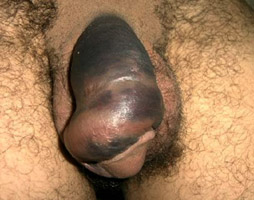
Predisposing factors include excessive force at coitus or manipulation, fibrosclerosis of the tunica albuginea and chronic urethritis. Cause may vary from region to region depending on the socio–cultural characteristics, masturbation habits and indulgence in sexual activities. In the Western world the most common cause, accounting for about 30%-50% of cases, is over enthusiastic sexual intercourse. Of those, woman-on-top positions resulting in impact against the female pelvis or perineum and bending laterally are most common. In Middle Eastern countries the common cause is physical manipulation of the penis to remove an erection.5,7 Although, most injuries that result from masturbation come from forcibly hiding an erection without care and fracturing it. Rarely it may occur while turning over in bed, forced bending, or hastily removing or applying clothing when the penis is erect in over enthusiasm. In flaccid state it allows significant degree of deformation without any injury to the vital structures but in erected state it is vulnerable to blunt injury. As the penis changes from a flaccid state to an erect state, the thick tunica albuginea becomes very thi6
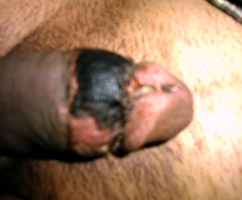
Predisposing factors include excessive force at coitus or manipulation, fibrosclerosis of the tunica albuginea and chronic urethritis. Cause may vary from region to region depending on the socio–cultural characteristics, masturbation habits and indulgence in sexual activities. In the Western world the most common cause, accounting for about 30%-50% of cases, is over enthusiastic sexual intercourse. Of those, woman-on-top positions resulting in impact against the female pelvis or perineum and bending laterally are most common. In Middle Eastern countries the common cause is physical manipulation of the penis to remove an erection.5,7 Although, most injuries that result from masturbation come from forcibly hiding an erection without care and fracturing it. Rarely it may occur while turning over in bed, forced bending, or hastily removing or applying clothing when the penis is erect in over enthusiasm. In flaccid state it allows significant degree of deformation without any injury to the vital structures but in erected state it is vulnerable to blunt injury. As the penis changes from a flaccid state to an erect state, the thick tunica albuginea becomes very thin from 2 mm to 0.25-0.5 mm; the tunica albuginea thins, stiffens, and loses elasticity and becomes easily fracturable.
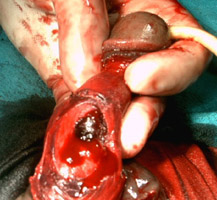
Acute onset of pain, swelling, and ecchymosis of the penis during sexual intercourse indicate a penile fracture until proven otherwise.’s fascia gives way and produces typical “butterfly-pattern” ecchymosis. Rolling sign can be demonstrated in fracture penis which is the movement of penile skin over the organized hematoma at the site of rupture of tunica albuginea. An entity called “false” penile fracture is a condition that closely mimics “true” penile fracture. Nonspecific dartos bleeding and avulsed superficial dorsal vein are causes. The absences of the “snap” and gradual detumescence both of which are distinguishing factors that suggest false fracture differentiates from true penile fracture but are not specific.xploration is deemed necessary. Surgical treatment has an advantage and is safe, effective, restores erectile function satisfactorily for patients and partners and is highly recommended. 5, 7, 13 14 Conservative management is associated with a high morbidity, and early surgical repair of the fracture is usually recommended in order to prevent complication. Nonoperative treatment results in a 10% incidence of penile deformity and requires a substantial hospital stay .Pulsative hematoma (pulsative diverticulum) is a very rare, early complication of a conservatively treated penile fracture.13 Sometimes false penis fracture requires venous ends ligation.
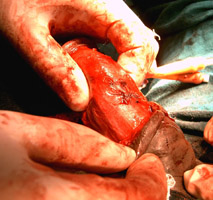
Associated injuries included urethral rupture occurring in 10% Delay in seeking treatment increases the complication rate non-surgical approaches result in 10%-50% complication rates including erectile dysfunction, permanent penile curvature, damage to the urethra, and pain during sexual intercourse. Immediate surgical repair in case of penile fracture is recommended for better functional outcome avoiding potential complications is associated with a low incidence of late complication.6, 5, 10, 15 But there are proponents surgical repair even in case of delayed presentation. Drugs have been advocated for spontaneous erection suppressionin post operative peroid. Abistence from all sexual activities for 6-8 weeks is recommended post surgery. Surgery consists of complete evacuation of the hematoma, curettage and repair of the tear with absorbable sutures in the tunica albuginea. A direct incision accurately over the defect gives optimum exposure with less tissue trauma, and can be performed under local anesthesia as a day-case surgery.16 Methylene blue-guided repair for trauma of the penis is considered to be an easy, reliable, safe, and fast method for spotting tears in the tunica albuginea of the corpora cavernosa or in the urethra, eliminating the need for unnecessary lengthening.17 Penile fracture is sometimes associated with urethral disruption, and needs repair, and value of retrograde urethrography in assessing urethral injuries in patients with penile fracture is highly stressed.Recently there has been recommended use of cyanoacrylic glue can be used in cavernous surgery due to its hemostatic, adhesive and anti-inflammatory properties.18
CONCLUSION
Penile fracture is a true surgical emergency. Trauma to erect penis is essential for getting fracture penis. Awareness of mode of trauma and clinical features is all that required for diagnosis and no more investigation is desirable. Surgical exploration is ideal for its management.
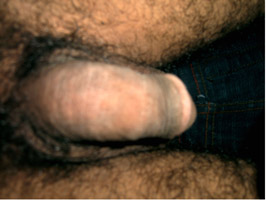
-
Gontero P, Muir GH, Frea P. Pathological Findings of Penile Fractures and Their Surgical Management. Urol Int 2003; 71:77-82.
-
Tejido Sánchez A, Martín Muñoz MP, Villacampa Abuá F, de la Morena Gallego JM, Suárez Charneco A, Leiva Galvis O. Surgical management of the penile fractures. Our experience. Actas Urol Esp 1999; 23:784-788.
-
Bar-Yosef Y, Greenstein A, Beri A, Lidawi G, Matzkin H, Chen J. Dorsal vein injuries observed during penile exploration for suspected penile fracture. J Sex Med 2007; 4:1142-1146.
-
Ateyah A, Mostafa T, Nasser TA, Shaeer O, Hadi AA, Al-Gabbar MA. Penile fracture: Surgical repair and late effects on erectile function. J Sex Med 2008; 5:1496-1502.
-
Eke N. Fracture of the penis. Br J Surg 2002; 89:555–565.
-
El Atat R, Sfaxi M, Benslama MR, Amine D, Ayed M, Mouelli SB, et al. Fracture of the penis: Management and long-term results of surgical treatment. Experience in 300 cases. J Trauma 2008; 64:121-125.
-
Zargooshi J. Penile fracture in Kermanshah, Iran: The long-term results of surgical treatment. BJU Int 2002; 89:890-894.
-
Perlmutter AE, Roberts L, Farivar-Mohseni H, Zaslau S. Ruptured superficial dorsal vein of the penis masquerading as a penile fracture: case report. Can J Urol 2007; 14:3651-3652.
-
Nale Dj, Nikić P, Vuković I, Djordjević D, Vuksanović A. Surgical or conservative treatment of penile fracture. Acta Chir Iugosl 2008; 55:107-114.
-
De Giorgi G, Luciani LG, Valotto C, Moro U, Praturlon S, Zattoni F. Early surgical repair of penile fractures: our experience. Arch Ital Urol Androl 2005; 77:103-105.
-
Cole FL, Vogler RW. Fractured penis. J Am Acad Nurse Pract 2006; 18:45-48.
-
El-Bahnasawy MS, Gomha MA. Penile fractures: the successful outcome of immediate surgical intervention. Int J Impot Res 2000; 12:273-277.
-
Dorde N, Sava Mićić. Pulsative hematoma-a penile fracture complication. Vojnosanit Pregl 2007; 64:58-60.
-
Uygur MC, Gülerkaya B, Altuğ U, Germiyanoğlu C, Erol D. 13 years’ experience of penile fracture. Scand J Urol Nephrol 1997; 31:265-256.
-
Kochakarn W, Viseshsindh V, Muangman V. Penile fracture: long-term outcome of treatment. J Med Assoc Thai 2002; 85:179-182.
-
Narayan
-
Shaeer O. Methylene blue-guided repair of fractured penis. J Sex Med 2006;3:349–354
-
Akgül T, Ayyildiz A, Cebeci O, Nuhoğlu B, Ozer E, Germiyanoğlu C, et al. Effect of cyanoacrylic glue on penile fracture: an experimental study. J Urol 2008; 180:749-752.